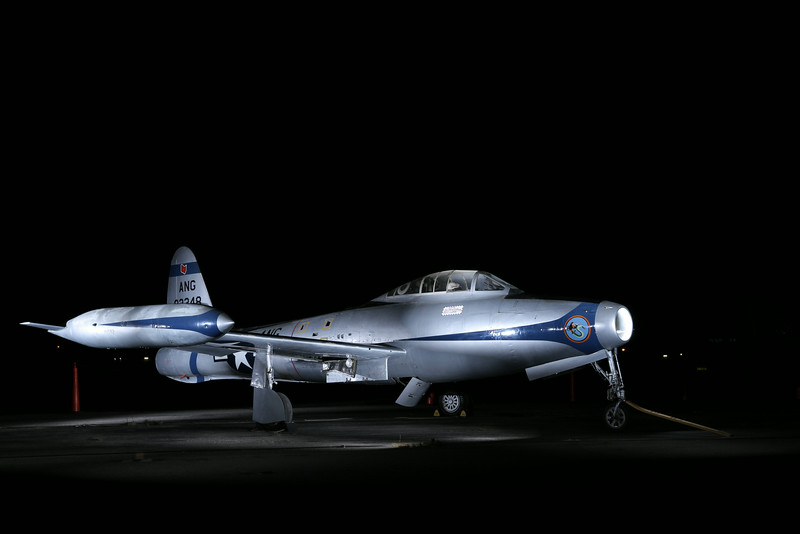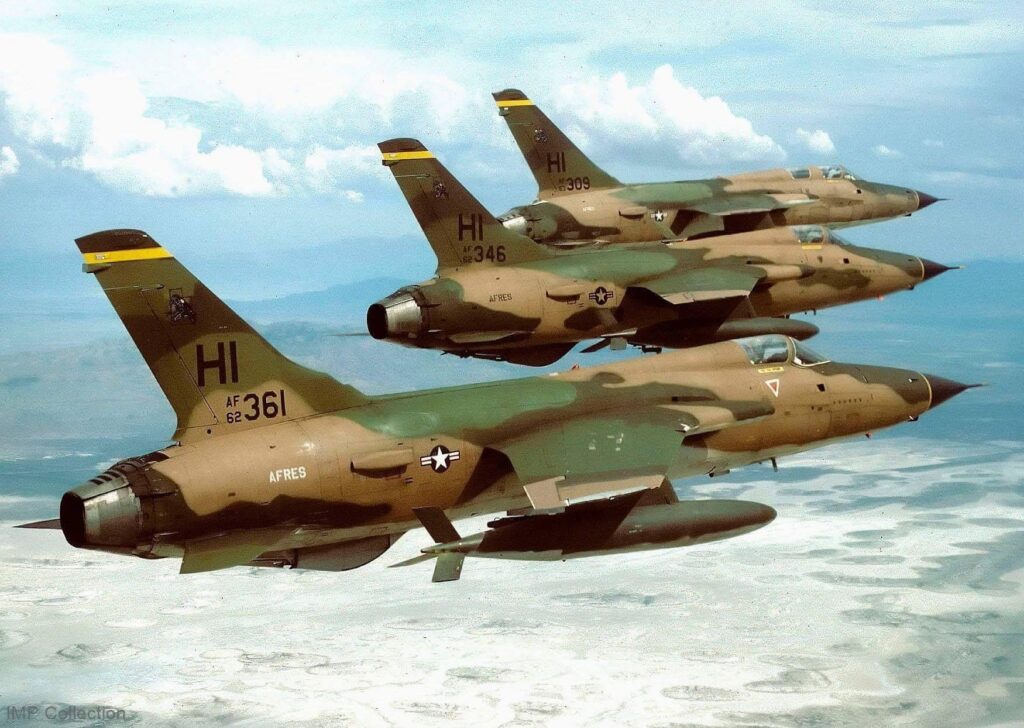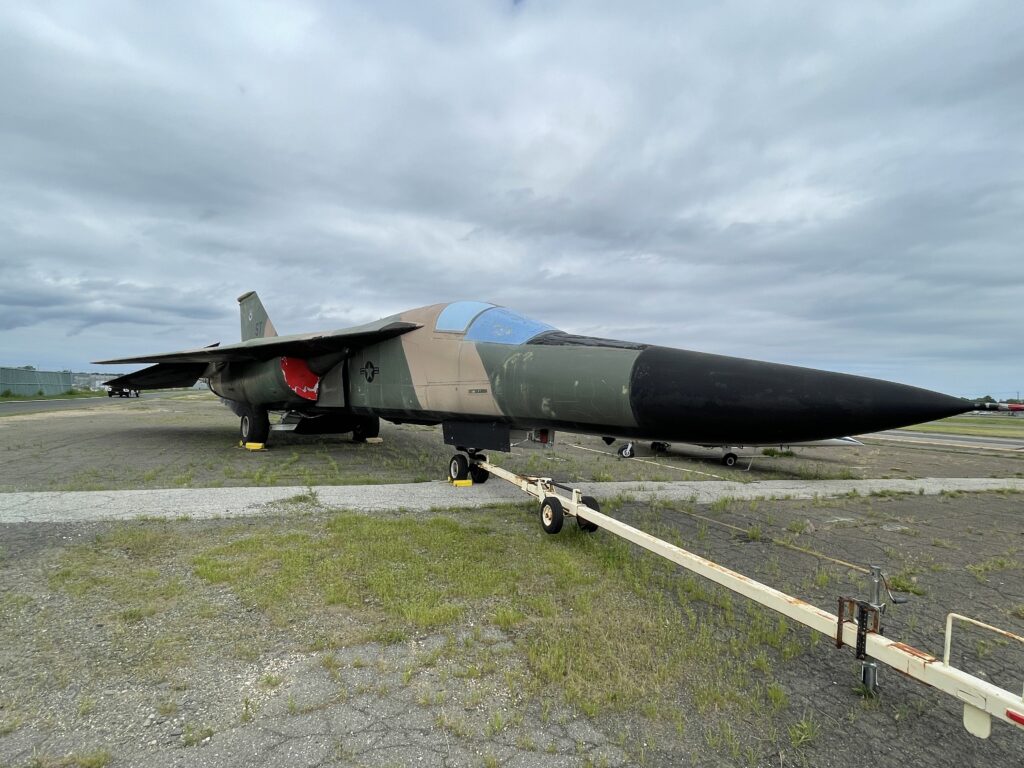Republic F-84E “Thunderjet”

Aircraft: Republic F-84E “Thunderjet” Current Status: Static History: The Republic F-84 “Thunderjet” was the second widely produced turbojet fighter-bomber aircraft for the US Air Force. The F-84 first flew in 1946 and entered service in 1947. The F-84 was not considered fully operational until the 1949 with F-84D production and the design matured with the F-84E and then G introduced entering service in 1951. The “Thunderjet” became the Air Force’s primary strike aircraft during the Korean War, flying 86,408 missions and destroying 60% of all ground targets in the war as well as eight Soviet-built MiG fighters. Over half of the 7,524 F-84s produced served with NATO nations, and it was the first aircraft to fly with the U.S. Air Force Thunderbirds demonstration team. The USAF Strategic Air Command had F-84 “Thunderjet” in service from 1948 through 1957. Notable achievements; The F-84 was the first aircraft flown by the U.S. Air Force Thunderbirds, which operated F-84G Thunderjets from 1953 to 1955 and F-84F Thunderstreaks from 1955 to 1956. The F-84E was also flown by the Skyblazers team of United States Air Forces Europe (USAFE) from 1950 to 1955. On 7 September 1946, the second XP-84 prototype set a national speed record of 607.2 mph), a bit slower than the world record 612.2 mph) held by the British Gloster Meteor. On 22 September 1950, two EF-84Es, flown by David C. Schilling and Col. William Ritchie, flew across the North Atlantic from Great Britain to the United States. Ritchie’s aircraft ran out of fuel over Newfoundland but the other successfully made the crossing which took 10 hours 2 minutes and three aerial refuelings. The flight demonstrated that large numbers of fighters could be rapidly moved across the Atlantic. F-84G was the first fighter with built-in aerial refueling capability and the first single-seat aircraft capable of carrying a nuclear bomb. On 20 August 1953, 17 F-84Gs utilizing aerial refueling flew from the United States to the United Kingdom. The 4,485-mile journey was the longest nonstop flight by jet fighters at the time. In 1955, an F-84G became the first aircraft to be Zero length launched from a trailer. About Our Republic F-84E “Thunderjet”: The American Airpower Museum Republic F-84E “Thunderjet” is a static aircraft on loan from the National Museum of the United States Air Force.
Republic F-105D “Thunderchief”

Aircraft: Republic F-105D “Thunderchief” Current Status: Static History: The Republic F-105 Thunderchief, was a supersonic fighter-bomber used by the United States Air Force. The Mach 2 capable F-105 conducted the majority of strike bombing missions during the early years of the Vietnam War; it has the dubious distinction of being the only US aircraft to have been removed from combat due to high loss rates. Originally designed as a single-seat, nuclear-attack aircraft, a two-seat Wild Weasel version was later developed for the specialized Suppression of Enemy Air Defenses (SEAD) role against surface-to-air missile sites. The F-105 was commonly known as the “Thud” by its pilots and crews. The F-105 was armed with missiles and a cannon, its design was tailored to high-speed low-altitude penetration carrying a single nuclear weapon internally. First flown in 1955, the Thunderchief entered service in 1958. Following adoption, the F-105 could deliver a greater bomb load than the large strategic bombers of World War II like the B-17 Flying Fortress and B-24 Liberator. The F-105 was one of the primary strike bombers of the Vietnam War; over 20,000 Thunderchief sorties were flown, with 382 aircraft lost (nearly half of the 833 produced) including 62 operational losses. Although less agile than smaller MiG fighters, USAF F-105s were credited with 27.5 kills. During the Vietnam war, the single-seat F-105D was the primary aircraft delivering the heavy bomb loads against the various military targets. Meanwhile, the two-seat F-105F and F-105G Wild Weasel variants became the first dedicated Suppression of Enemy Air Defenses (SEAD) platforms, fighting against the Soviet-built S-75 Dvina (NATO reporting name: SA-2 Guideline) surface-to-air missiles. Two Wild Weasel pilots were awarded the Medal of Honor for attacking North Vietnamese surface-to-air missile sites, with one shooting down two MiG-17s the same day. The dangerous missions often required them to be the “first in, last out”, suppressing enemy air defenses while strike aircraft accomplished their missions and then left the area. As the largest single-seat, single-engine combat aircraft in history, the F-105 weighed approximately 50,000 pounds It could exceed the speed of sound at sea level and Mach 2 at high altitude, and carry up to 14,000 lbs. of bombs and missiles. The Thunderchief was later replaced as a strike aircraft over North Vietnam by both the McDonnell Douglas F-4 Phantom II and the swing-wing General Dynamics F-111 Aardvark. However, the F-105 remained in service in the USAF Reserve and Air National Guard until retired in February 1984 at the 419th TFW at Hill AFB, UT. About Our Republic F-105D “Thunderchief”: The American Airpower Museum Republic F-105D-31RE Tail# 62-4361 was accepted by the United States Air Force at the Republic Aviation Plant (The ground of the American Airpower Museum today) on 30 August 1963. Delivered to the 8th Tactical Fighter Wing at Itazuke AB, Japan in 1963. It would be transferred to the 6441 TFW at Yakota, AB Japan in 1965. The 6441 TFW would be transferred to Takhli Royal Thai Airbase, Thailand as the Vietnam War air war ramped up. In 1966 our F-105D transferred to the 388th TFW at Korat, RTAB Thailand. While assigned to the 388th TFW, 62-4361 was flown by the 469th Tactical Fighter Squadron during Rolling Thunder in December of 1967. It would go on to fly with the 469th, and then the 44th TFS until October of 1969. 62-4361 would be transferred as part of the 44th TFS to the 355th TFW at Takhli RTAB, Thailand. 62-4361would be one of the last F-105s to leave Southeast Asia in October of 1970 when the 355th TFW was the last F-105 unit be redeployed out of combat operations. 62-4361 would fly with the 184 TFG at McConnell ADB until 1979 and would then be assigned to the United States Air Force Reserve 465 TFS at Tinker AFB, OK in 1980. The same year 62-4361 would be assigned to its final flying assignment and fly with the 419th TFW at Hill AFB, UT and remain flying until the “Thud out” final retirement of the last F-105s with the 419th TFW in February of 1984. It would flown out of Hill and would be on display at Rickenbacker International Airport in Columbus OH until 2000. In 2000, with the help of Legendary Thud Pilot, and author of Thud Ridge, Col. Jack Broughton, USAF Ret. the National Museum of the United States Air Force would transfer 62-4361 to the American Airpower Museum where it has been on loan and displayed for the public for 20 years.
General Dynamics F-111A “Ardvark”

Aircraft: General Dynamics F-111A “Ardvark” Current Status: Static History: The General Dynamics F-111 “Aardvark” was a medium-range interdictor and tactical strike aircraft that also filled the roles of strategic bomber, reconnaissance, and electronic countermeasures. Developed in the 1960s by General Dynamics, it first entered service in 1967 with the United States Air Force with the F-111A. The Royal Australian Air Force (RAAF) also ordered the type and began operating F-111Cs in 1973. The F-111 pioneered several technologies for production aircraft, including variable-sweep wings, afterburning turbofan engines, and automated terrain-following radar for low-level, high-speed flight. Its design influenced later variable-sweep wing aircraft, and some of its advanced features have since become commonplace. During its initial development the F-111 suffered a variety of problems, and several of its intended roles, such as naval interception, with the F-111B, failed to materialize. On 14 April 1986, 18 F-111s and approximately 25 Navy aircraft conducted air strikes against Libya under Operation El Dorado Canyon in response to the downing of Pan Am flight 800. The 18 F-111s of the 48th Tactical Fighter Wing and the 20th Tactical Fighter Wing flew what turned out to be the longest fighter combat mission in history. The round-trip flight between RAF Lakenheath/RAF Upper Heyford, United Kingdom and Libya of 6,400 miles spanned 13 hours. One F-111 was lost over Libya, probably shot down. F-111s participated in Gulf War (Operation Desert Storm) in 1991. During Desert Storm F-111Fs completed 3.2 successful strike missions for every unsuccessful one, making it the leading strike aircraft. The group of 66 F-111Fs dropped almost 80% of the war’s laser guided bombs, including the GBU-15 and the penetrating, bunker-buster GBU-28. Eighteen F-111Es were also deployed during the operation. The F-111s were credited with destroying more than 1,500 Iraqi tanks and armored vehicles. Their use in the anti-armor role was dubbed “tank-plinking“. The F-111 was in service with the USAF from 1967 through 1998. The Strategic Air Command had FB-111s in service from 1969 through 1990. At a ceremony marking the F-111’s USAF retirement, on 27 July 1996, it was officially named Aardvark, its long-standing unofficial name. The USAF retired the EF-111 variant in 1998. The RAAF was the last operator of the F-111, with its aircraft serving until December 2010 About Our General Dynamics F-111A “Ardvark”: The American Airpower Museum General Dynamics F-111A is currently on loan from the National Museum of the United States Air Force.

